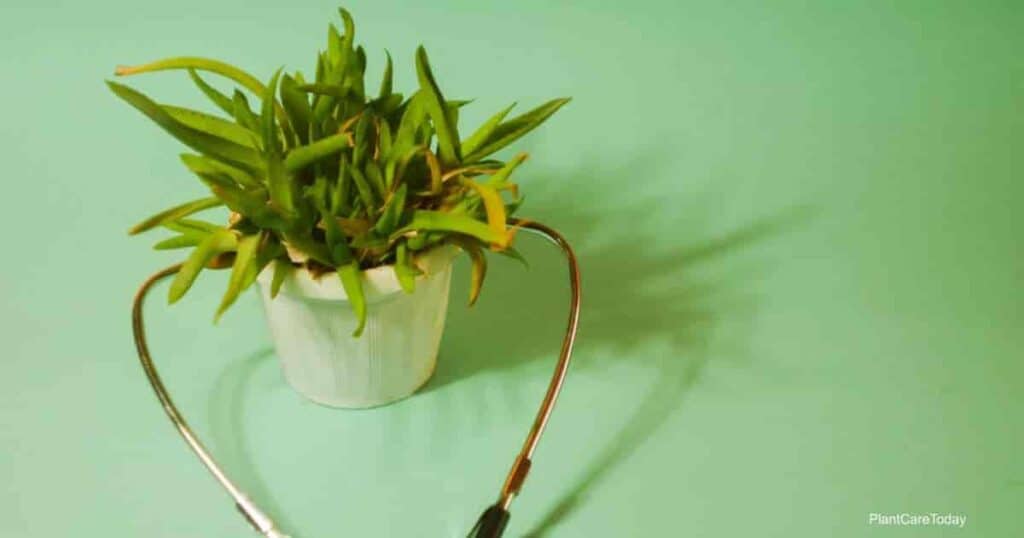[ad_1]
Aloe vera is the Black Knight of the plant world.
No matter how much you neglect it, how often you break off a leaf to treat burns, or even how often birds nibble on it, aloe vera shrugs and insists it’s just a flesh wound.
However, whenever your aloe claims it’s invincible, you can rightly call it a loony (you may also want to visit a professional if your plant is actively talking to you).
One of the most notorious weaknesses of an aloe plant is root rot. This deadly disease can come from bacterial or fungal infections that can quickly kill an aloe if not treated early enough.
Aloe Vera Root Rot (Signs, Causes, And Solutions)
Plants signal when something’s wrong, and knowing these signs can help you quickly diagnose and address a problem.
Thankfully, root rot is curable if caught early. The following guide will help you identify the signs and causes and how to treat this deadly infection.
Symptoms Of Root Rot
The most obvious signs your aloe may have root rot are in leaf coloration.
Water or lighting issues can cause the leaves to yellow, which might be the earliest warning of root rot.
More importantly, if the leaves are beginning to turn brown and mushy, you have a high chance that root rot is the cause.
This can be an advanced symptom that may even encompass the entire leaf but will start at the base of the leaves, at which point it might not be too late.
When you see browning at the plant base, especially if paired with some yellowing or a foul smell, you need to check the root ball immediately.
Infected roots will be dark brown or black (if dead), and the higher the percentage of infected roots, the lower the plant’s chance of survival.
What Causes Root Rot?
A few potential causes for root rot come down to fundamental (and preventable) care issues.
The most common causes are:
- Improper watering
- Poor drainage
- Cross-contamination
- Soil-based fungal growth (fungus gnats are often a sign there’s fungi present)
While other causes can cause root rot in other plants, aloe very rarely has the same issues (such as container size).
Treating Root Rot In Aloe Vera
It’s important to treat root rot when you have a diagnosis.
This begins with removing your aloe vera from the soil and thoroughly examining the roots.
With some isopropyl or rubbing alcohol on hand (both work, but the higher the percentage you use, the better), grab some sharp shears and begin removing any black or dark brown roots.
Healthy roots are often light brown and may have a slight green tinge, so be careful not to remove these.
Make sure you sterilize the shears in your alcohol between every cut.
Once the infected roots are gone, continue to remove any other infected portions of the plant.
Treating Critical Infections
This is one of the few plants that can survive if you cut away the entire root ball if it’s rotted out.
Just be sure to cut above the infected area.
You will need to do one additional step before proceeding, which involves letting the plant air dry in a warm spot for a few days.
This allows the amputation point to harden, making it more resistant to infection.
Sterilizing the Plant
Once only healthy roots remain, dop the roots in a fungicidal solution or a solution made from 1 part bleach to 10 parts water.
If using bleach, give the plant a day to air dry.
Wrapping the root system in a soft cloth can also help dry regardless of your method.
Once dry, you can dip the base of the plant in the rooting hormone. While not necessary, this extra step can help your aloe plant recover, especially if the damage is extensive.
Preparing the Pot
The aloe will need to be planted in a pot with good drainage holes.
If your previous pot had enough drainage, you could sterilize it by soaking the container in a solution of 1 part bleach to 9 parts water for 30 minutes, then allowing it to dry.
Aloe is adapted for porter soil conditions, so you may wish to add a ½ to 1″ inch base layer of gravel or aquarium stones to the bottom of the pot to serve as an additional buffer in case of overwatering.
Use fresh, sterile potting soil and add an aggregate such as coarse sand or perlite to prevent the soil from compacting.
Finally, water the soil lightly so it’s evenly moist but not wet before planting the aloe.
Prevention
Preventing root rot is much easier than treating it and doesn’t require special care.
The following are some simple tips that can help prevent root rot and will keep your aloe at its best:
- Always use the soak-and-dry method when watering your plant.
- When increasing container size, always only use one size larger.
- Never buy cheap potting soil unless it’s from a reputable source (Miracle-Gro).
- Give your aloe vera fresh potting soil when dividing the plant.
- Avoid exposing the plant to infected plants or unsterilized equipment.
- Keep an eye out for fungus gnats or unusual tints to the potting soil that may suggest the presence of mold or fungus.
[ad_2]
Source link









 + Planting String of Watermelon Succulents
+ Planting String of Watermelon Succulents  with Garden Answer
with Garden Answer


